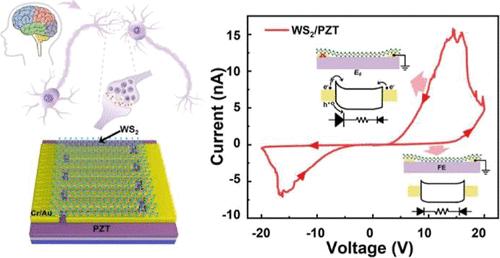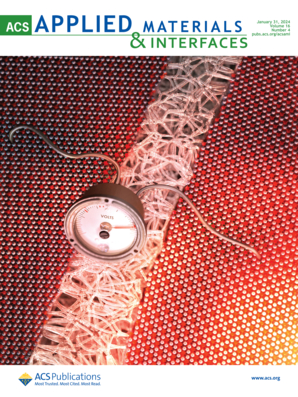In-Plane Polarization-Triggered WS2-Ferroelectric Heterostructured Synaptic Devices
IF 8.3
2区 材料科学
Q1 MATERIALS SCIENCE, MULTIDISCIPLINARY
引用次数: 0
Abstract
To date, various kinds of memristors have been proposed as artificial neurons and synapses for neuromorphic computing to overcome the so-called von Neumann bottleneck in conventional computing architectures. However, related working principles are mostly ascribed to randomly distributed conductive filaments or traps, which usually lead to high stochasticity and poor uniformity. In this work, a heterostructure with a two-dimensional WS2 monolayer and a ferroelectric PZT film were demonstrated for memristors and artificial synapses, triggered by in-plane ferroelectric polarization. It is noted that the properties of the WS2/PZT heterostructures, including photoluminescence (PL) and conductivity, can be effectively tuned by in-plane polarization. In contrast to conventional memristors, the resistance switch of our memristors relies on the dynamic regulation of Schottky barriers at the WS2/metal contacts by ferroelectric polarization. PL characterizations verified the existence of lateral fields inside the WS2 originating from the polarization of the PZT. In particular, such memristors can emulate neuromorphic functions, including threshold-driven spiking, excitatory postsynaptic current, paired-pulse promotion (PPF), and so on. The results indicate that the WS2/PZT heterostructures with in-plane polarization are promising for the hardware implementation of artificial neural networks.

面内极化触发ws2 -铁电异质结构突触器件
迄今为止,各种忆阻器已被提出作为神经形态计算的人工神经元和突触,以克服传统计算架构中所谓的冯·诺伊曼瓶颈。然而,相关的工作原理大多归因于随机分布的导电丝或陷阱,这通常导致随机性大,均匀性差。在这项工作中,展示了二维WS2单层和铁电PZT薄膜的异质结构,用于记忆电阻器和人工突触,由平面内铁电极化触发。研究发现,利用面内极化可以有效地调节WS2/PZT异质结构的光致发光和电导率。与传统的忆阻器相比,我们的忆阻器的电阻开关依赖于铁电极化对WS2/金属触点处肖特基势垒的动态调节。PL表征证实了WS2内部存在源于PZT极化的侧向场。特别是,这种忆阻器可以模拟神经形态功能,包括阈值驱动的尖峰,兴奋性突触后电流,成对脉冲促进(PPF)等。结果表明,具有面内极化的WS2/PZT异质结构是人工神经网络硬件实现的理想材料。
本文章由计算机程序翻译,如有差异,请以英文原文为准。
求助全文
约1分钟内获得全文
求助全文
来源期刊

ACS Applied Materials & Interfaces
工程技术-材料科学:综合
CiteScore
16.00
自引率
6.30%
发文量
4978
审稿时长
1.8 months
期刊介绍:
ACS Applied Materials & Interfaces is a leading interdisciplinary journal that brings together chemists, engineers, physicists, and biologists to explore the development and utilization of newly-discovered materials and interfacial processes for specific applications. Our journal has experienced remarkable growth since its establishment in 2009, both in terms of the number of articles published and the impact of the research showcased. We are proud to foster a truly global community, with the majority of published articles originating from outside the United States, reflecting the rapid growth of applied research worldwide.
 求助内容:
求助内容: 应助结果提醒方式:
应助结果提醒方式:


